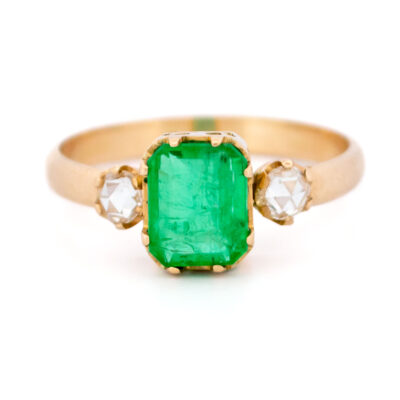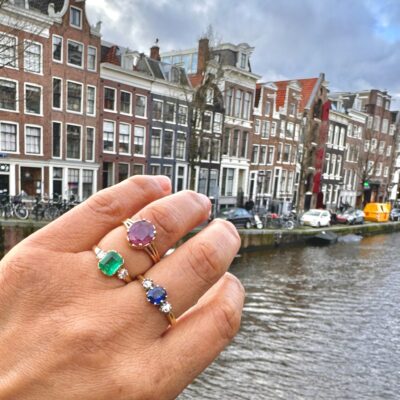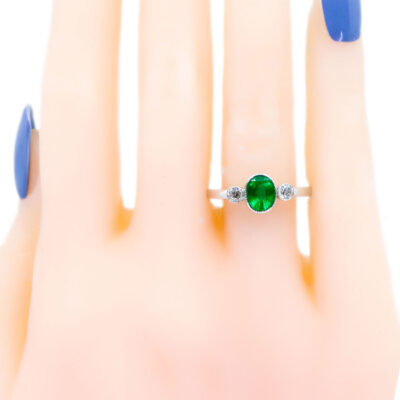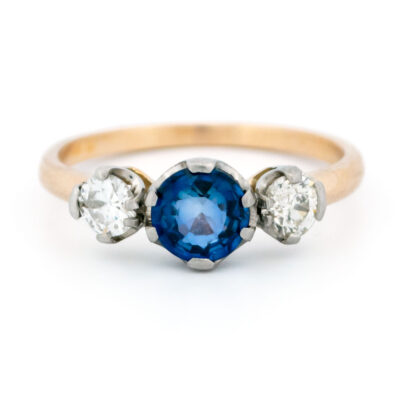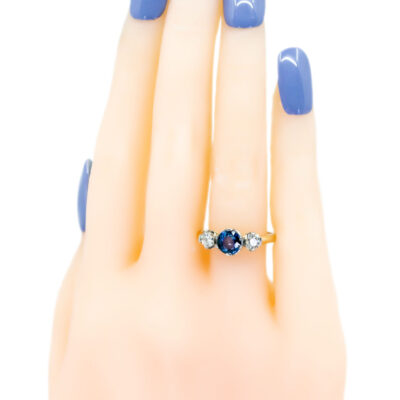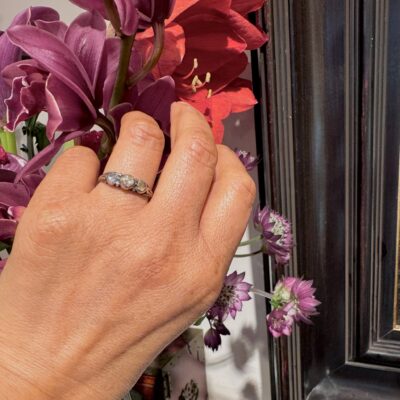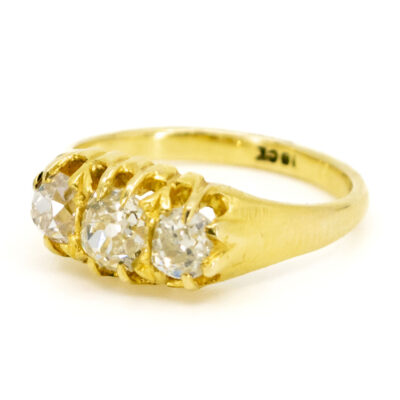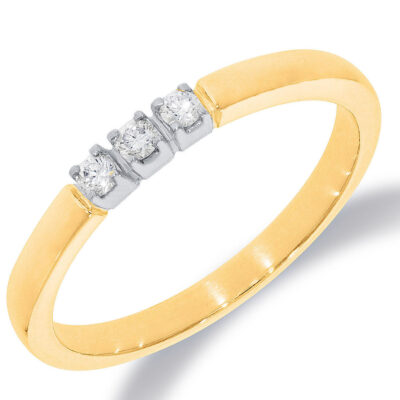Indulge in vintage elegance with this Binenbaum Revival trilogy ring. ✨ Three sparkling gems take center stage: a mesmerizing 3.30ct oval morganite flanked by two delicate rose-cut diamonds (approx. 0.45ct tw). Crafted in luxurious 18k gold for a timeless piece.
Videos
Details: ±3.30ct Morganite, ±0.45ct Rose-cut diamond, 18k Ring.
Design Era: Binenbaum Vintage Revivals.
Size: 17.93 NL / 56.3 FR / 7¾ US / P UK.
Weight in grams: 4.6.
Condition: Refurbished.
Shipping and Pickup: This fine quality piece ships from our store located in the center of Amsterdam, The Netherlands. We offer both registered shipping and local pickup at our store. In the case of local pickup, any applicable shipping costs will be refunded.
About Us: Add some sparkle to your style with Binenbaum.com. We offer a stunning selection of antique and vintage jewelry that you won’t find anywhere else. From timeless rings and dazzling necklaces to unique brooches, we have something for every taste and occasion. Visit our website today and treat yourself to a piece of history.
| Design Era | |
|---|---|
| Design & Historical Context | At Binenbaum, our 40-year legacy, dating back to the early '80s, is more than just selling jewelry; it's about crafting timeless pieces that blend history with modern quality. Introducing our latest creation: Binenbaum Vintage Revivals. This unique collection draws inspiration from historic eras like Art Deco and Victorian to create contemporary designs that resonate with timeless elegance. But what truly sets Binenbaum Vintage Revivals apart is our commitment to sustainable luxury. We don't just mimic vintage styles; we revitalize and repurpose antique jewelry, ensuring each piece is both enduring and exquisite. In doing so, we infuse our personal touch into every creation, making each item a tribute to the rich history of jewelry and a story yet to be told. |
| Key Materials | |
| Materials & Craftsmanship | Morganite: The Gem of Love and Compassion Morganite, a beautiful peach-pink variety of beryl, is cherished for its soft, romantic hue and its associations with love, compassion, and emotional healing. Often referred to as the pink emerald due to its close relation to emerald and aquamarine, morganite is a gemstone that exudes a gentle warmth and elegance, making it a popular choice for those seeking a stone with both beauty and meaning. Discovered in Madagascar in the early 20th century, morganite was named in honor of the American financier and gem enthusiast J.P. Morgan by the famous gemologist George Kunz. Morganite quickly gained popularity in the world of fine jewelry, especially for its delicate color and excellent clarity. In modern jewelry, morganite is prized for its subtle, pastel tones that range from soft pinks to peachy apricots. Its feminine charm makes it a popular choice for engagement rings, where it offers a unique and romantic alternative to more traditional stones like diamonds. With a Mohs hardness of 7.5 to 8, morganite is durable enough for everyday wear, especially when set in protective settings like bezels or halos. Morganite's soft glow pairs beautifully with rose gold, enhancing its pinkish tones and creating a harmonious, blush-colored piece. It is also stunning in white or yellow gold settings, where its color can stand out as a warm and inviting focal point. Beyond its aesthetic appeal, morganite is believed to have strong metaphysical properties. It is often associated with the heart chakra, encouraging emotional healing, love, and compassion. Many consider morganite a stone of divine love, bringing a sense of peace, joy, and inner strength to those who wear it. Morganite is more than just a gemstone; it is a symbol of gentle love and emotional harmony. Its delicate color and associations with the heart make it a meaningful and elegant choice for jewelry that celebrates life's most cherished moments. Whether chosen for its beauty, its symbolism, or both, morganite adds a touch of warmth and romance to any jewelry collection. Rose-cut diamond: The Vintage Gem of Romance and Light Rose-cut diamonds are a beautiful and romantic choice in the world of jewelry, known for their distinctive dome-shaped appearance and soft, glowing sparkle. This antique diamond cut, dating back to the 16th century, features a flat bottom and a domed top covered in triangular facets that resemble the petals of a rosebud—hence the name. Historically, rose-cut diamonds were highly prized during the Georgian and Victorian eras, often used in jewelry pieces meant to be worn in candlelight, where their gentle sparkle added a warm, intimate glow. Unlike modern brilliant cuts, which are designed for maximum fire and brilliance, rose-cut diamonds offer a more subdued, yet enchanting, reflection of light. In modern jewelry, rose-cut diamonds are cherished for their vintage appeal and unique charm. Their flat base and shallow profile make them perfect for creating low-profile, elegant designs that sit close to the skin, such as in rings, pendants, and earrings. Rose-cut diamonds are often used in vintage-inspired and bespoke pieces, where their historical elegance adds a touch of timeless romance. Rose-cut diamonds are more than just a gemstone choice; they are a symbol of understated beauty and classic romance. Their soft, luminous sparkle and antique allure make them an ideal choice for jewelry that tells a story and captures the essence of a bygone era. 18k: The Perfect Balance of Luxury and Durability 18k gold is a luxurious and highly sought-after material in the world of fine jewelry, known for its rich color, durability, and value. The 18k refers to the purity of the gold, indicating that it is composed of 75% pure gold and 25% alloyed metals, such as copper, silver, or palladium. This combination provides the perfect balance between the softness of pure gold and the strength needed for creating durable jewelry. Historically, gold has been prized for its beauty and rarity, symbolizing wealth, power, and status across various cultures and civilizations. 18k gold has been a preferred choice in fine jewelry for centuries due to its ideal blend of purity and strength, offering a radiant gold color that is more vibrant than lower karat golds while still being hard enough for everyday wear. In modern jewelry, 18k gold is favored for its versatility and its ability to enhance the appearance of gemstones. It is available in several colors, including yellow, white, and rose gold, depending on the metals used in the alloy. Each color has its unique appeal: Yellow Gold: The classic choice, offering a warm, rich hue that pairs beautifully with a wide range of gemstones and complements all skin tones. White Gold: A sleek, modern option that resembles platinum or silver but with the strength and luxury of gold. It is often rhodium-plated to enhance its reflective surface. Rose Gold: A romantic, pinkish hue that has gained popularity for its vintage charm and contemporary appeal, achieved by alloying gold with copper. 18k gold is commonly used in engagement rings, wedding bands, earrings, necklaces, and bracelets, where its balance of durability and beauty makes it ideal for both intricate designs and simple, elegant pieces. The alloy's added strength ensures that jewelry can withstand daily wear while maintaining its luster and shape. 18k gold is more than just a material; it is a symbol of refined taste and enduring value. Its perfect blend of luxury and practicality makes 18k gold a timeless choice for those who seek the beauty of high-purity gold without sacrificing durability. Whether in classic or modern designs, 18k gold jewelry offers a radiant and lasting expression of elegance and sophistication. |
| Size | |
| Gender | |
| Weight (in grams) | 4.6 |
| Condition |
By following these tips, you can enjoy your precious jewelry for many years to come.
Related Products
-
Emerald Diamond 18k Trilogy Ring 15733-5207
€ 3.295,00 VAT incl. (where applicable) -
Emerald Diamond 14k Trilogy Ring 13709-8213
€ 2.995,00 VAT incl. (where applicable) -
Diamond Sapphire 14k Platinum Trilogy Ring 14408-5114
€ 3.295,00 VAT incl. (where applicable) -
Diamond 14k Trilogy Ring 16992-9046
€ 925,00 VAT incl. (where applicable) -
Diamond 14k Trilogy Ring 16902-9008
€ 1.695,00 VAT incl. (where applicable) -
Diamond 14k Silver Trilogy Ring 15934-8618
€ 1.595,00 VAT incl. (where applicable) -
Diamond 18k Trilogy Ring 10590-6657
€ 3.395,00 VAT incl. (where applicable) -
Diamond 14k Trilogy Ring 17036-9083
€ 895,00 VAT incl. (where applicable)
- Home
- Collection
- Fine Jewelry
- Silver Jewelry
- Silverware
- Boxes
- Candlesticks
- Salt and pepper shakers
- Miniatures
- Salt cellars
- Spoon Set
- Condiments
- Frames
- Napkin Ring
- Spoon
- Oddities
- Cups
- Vases
- Cutlery
- Serving Spoon And Cake Server
- Candlesticks
- Baskets
- Hanukkiah
- Spice Tower
- Yad
- Tea Set
- Sugar Castor
- Napkin Rings
- Wine Bottle Coaster
- Wine Stopper
- Tea Pot
- Jugs
- Rattles
- Hip Flask
- Miscellaneous
- Rings 💍
- About
- Contact







